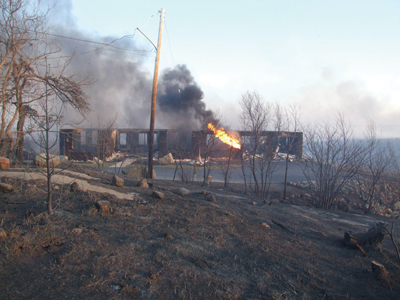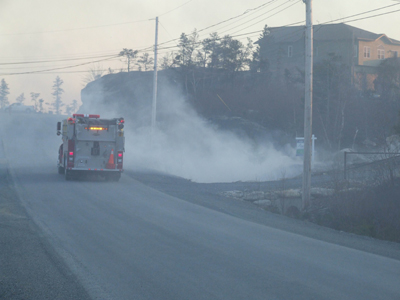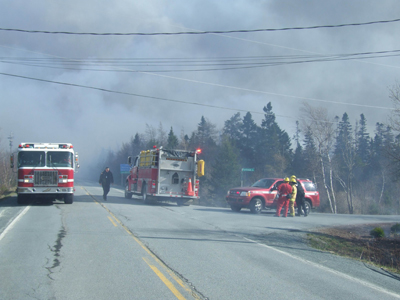
Features
Training
Trainer’s Corner: Wildland fire preparedness
Wildland fires are associated with out-of-control burning, high intensity, high flames and high rates of spread. Fed by high temperatures, low humidity and low rainfall, the fire-prone vegetation that shares space with manmade structures can destroy whole communities. Each year, there are thousands of forest fires in Canada. Although most are far from populated areas, there have certainly been tragic exceptions.
June 1, 2009
By Ed Brouwer
Wildland fires are associated with out-of-control burning, high intensity, high flames and high rates of spread. Fed by high temperatures, low humidity and low rainfall, the fire-prone vegetation that shares space with manmade structures can destroy whole communities. Each year, there are thousands of forest fires in Canada. Although most are far from populated areas, there have certainly been tragic exceptions.

|
| Fuel oil continues to burnoff at a house destroyed during the massive brush fire in Halifax in April/May. (Photo courtesy Halifax Regional Fire & Emergency Services)
|
According to Natural Resources Canada (www.nrcan.gc.ca), in July 1911, after two months of unreasonably high temperatures, several small fires converged into a giant conflagration. The massive blaze swept through 10 isolated mining communities near Timmins, Ont., and a mining area known as Camp Porcupine. Residents of South Porcupine became trapped and were unable to escape the fire as the town burned to the ground.
According to a section on the NRC website devoted to Northern Ontario disasters, “The high winds created by the fire reached gale-force speeds, reportedly so powerful that [they] sucked tree trunks out of the ground and flung them through the air, where they would either explode or be dropped into another piece of tinder dry fuel.”
The website says the intense heat caused buildings, timber and clothing to combust. At the nearby West Dome Lake Mine, the mine managerhurried his family and employees down into the mineshaft in hopes of protection from the fire. Sadly however, the passing fire pulled the oxygen from the mineshaft. The family was untouched by the fire but was asphyxiated. The next day, the same fire swept through the town of Cochrane, Ont. Three communities were destroyed and 77 people were officially listed as dead, though the number of unrecorded deaths will never be known.
Then there was the fire of 1916 known as the Matheson fire, named for a town that was completely annihilated. According to the website, “July 30 was a frightening day, almost a repeat of the events that had happened only five years previously. This time, the fire consumed nearly 800 square miles of forest, and the toll reached an unheard of 282 official deaths.
“Nushka, just down the T&NO line from Matheson, was particularly hard hit. As the fire approached the town, the local priest, Father Gagne, led 56 people to a field outside of town. There was no other place to go. All 56 people were asphyxiated when the flames surrounded the field. As a memorial to Father Gagne’s efforts, the community was renamed Val Gagne.”

|
|
| Tanker 41 (Waverley) moves back into Fortress Drive in Halifax after a brush fire ripped though the suburban area. Four homes were lost on this street. (Photo courtesy Halifax Regional Fire & Emergency Services) | |

|
|
| Halifax fire crews gather around Div. Capt. (Safety) Dave Meldrum’s car after retreating from Fortress Drive, where several homes were on fire.
|
The summer of 2003 will be remembered as the year B.C. burned. Three firefighters lost their lives – Ian Mackay, a 41-year-old father of four, Eric Ebert, 32, and Ben Von Hadenberg, 33, who was to be married two days after his death. In addition, 335 homes were lost or damaged, 38,009 people were forced to leave their homes and 148,695 hectares were lost to fire. My crew and I spent more than 50 days working wildland/interface fires in the Okanagan that year.
Most firefighting methods deal with fire that starts inside and burns outward. However, a wildland fire starts on the outside and tries to get in. There are not too many wildfires today that don’t threaten something.
Although there have been volumes written on suppression tactics and firefighter safety, I believe we’ve missed the boat. Fire departments should play a more effective role in the area of prevention and preparedness. (See sidebar below.)
The bottom line for us in 2003 was that we had not done enough in the area of prevention and preparedness – not nearly enough. Many of the fires burned where homes were located in or near the woods (wildland-urban interface). Some of those fires very quickly exceeded the suppression capabilities of the local fire services.
Because of the intensity of a wildfire, no fire department can guarantee the safety of a home or its residents. However, homeowners can protect their families and their properties from wildland fires.
We need to heighten public awareness about the dangers of wildfire in the urban interface. One of your department’s goals should be to empower homeowners in your communities to protect their families and their homes from this threat by creating a safety zone called defensible space.
Wildfire awareness campaign materials are readily available online. The producers of this material encourage us to use the documents and make changes that are appropriate for our target audiences.
Handouts and tip cards are available at the Washington State Department of Natural Resources website – www.dnr.wa.gov (click on fire information and prevention, then wildfire awareness). Several pamphlets and/or tip cards are available on topics including wildfires, debris burning, protecting your home from wildfires and preparing a house for wildland fire season. There’s also a wildfire-approaching checklist. The British Columbia Provincial Emergency Program website also has downloadable information on wildfire safety at www.pep.bc.ca/hazard_preparedness .
Fire departments can and should be more proactive in the areas of awareness, prevention and preparedness. With free material available through the FireSmart program there is no reason not to empower your community to take an active role in helping you prepare for and fight wildfires. If we learn from our past shortcomings, Canadians will not have to go through another wildfire season like those of the early 1900s and 2003.
Stay safe – until next time train like their lives depend on it, because they do.•
|
||||||||||||||||||||||||||||||||||||||
Print this page